|
|||||||||||||||||||||||
|
|||||||||||||||||||||||
|
|
|||||||||||||||||||||||
|
|||||||||||||||||||||||
|
[Text by Professor Roberto Mendonça Faria (IFSC-USP), former president of B-MRS.]
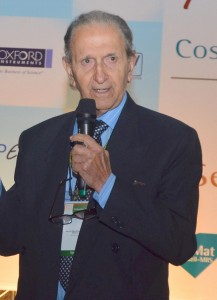
The Brazilian Materials Research Society (B-MRS) invited me to write about an event that no one would like to read: the demise of professor and scientist Sérgio Mascarenhas de Oliveira.
Sérgio Mascarenhas was born on May 2, 1928 in the city of Rio de Janeiro, where he graduated in chemistry from the National Faculty of Philosophy, University of Brazil, in 1951, and in physics from the University of Rio de Janeiro, in 1952.
In 1956, he, together with his wife, Professor Yvonne Primerano Mascarenhas, decided to face the great challenge of introducing research far from the big centers, such as São Paulo and Rio de Janeiro. They began their brilliant careers as professors and scientists in São Carlos, at the São Carlos School of Engineering – the University of São Paulo. With competency and hard work, Professor Mascarenhas created the first laboratories in the area of Condensed Matter Physics, an important segment of Materials Science, following the knowledge he brought from Rio de Janeiro, where he worked with the masters Joaquim Costa Ribeiro and Armando Dias Tavares, under the inspiration of Professor Bernhard Gross.
He created the Institute of Physics and Chemistry of São Carlos (where he was professor emeritus), the Embrapa Instrumentation (CNPDIA) unit in São Carlos, and was one of those responsible for founding the Federal University of São Carlos. He was visiting professor at the Universities of Princeton, Harvard, MIT (USA), the National Autonomous University and the Center for Advanced Studies (Mexico), the Institute of Physical and Chemical Research (Japan), the London University (England), the International Center for Theoretical Physics of Trieste and University of Rome (Italy). He was director of the Adib Jatene Research Foundation (Institute of Cardiology Dante Pazzanese SP), he also coordinated projects at the Institute of Advanced Studies at USP, and was a member of the Brazilian Academy of Sciences and the Academy of Sciences of the State of São Paulo. Professor Mascarenhas was decorated CNPq Researcher Emeritus, and received numerous awards: Commander of the National Order of Scientific Merit of the Presidency of the Republic, Guggenheim Award (USA), Fulbright Award (USA), Yamada Foundation Award (Japan), the National Order of Scientific Merit award – Grand Cross, among other honorary distinctions.
Professor Mascarenhas leaves a legion of students and former students who continue his work supporting the scientific development of Brazil.
Prof. Roberto Mendonça Faria.
B-MRS expresses deep regret for the death of Sérgio Mascarenhas Oliveira.
He was professor (retired) at the University of São Paulo (USP), and passed away on May 31, at the age of 93.
In 2012, B-MRS honored him with the “Memorial Lecture Joaquim da Costa Ribeiro” for his impact on the Brazilian Materials research community.
At this moment, the B-MRS Board would like to remember him as a great scientist who encouraged new talents and believed in collaborative work and in the entrepreneurial and creative capacity of the Brazilian people.
Nowadays, new functional materials of very small dimensions are welcome to face the interest in increasingly smaller and better performing devices. Even more so if their properties can be refined to meet the needs of each application.
A Brazilian scientific team developed a nanocomposite consisting of two-dimensional sheets of reduced graphene oxide (rGO) and ultra-small quantum dots, and found a way to adjust its electrical and optical properties, taking advantage of the synergy between both components. The discovery brings possibilities for using this nanomaterial in the development of more sensitive devices with new features, for areas like energy and health.
“With the surprising and innovative results of this work, the development of new nanocomposites emerges, aimed at training human resources and with wide applicability of the technology,” says Professor Noelio Oliveira Dantas (UFAL and UFU), corresponding author of the article who reports the finding in The Journal of Physical Chemistry C.
From Minas to Alagoas
The research began in 2016 in the Brasilian state of Minas Gerais, at the Federal University of Uberlândia (UFU), within the PhD of Rosinildo Fideles do Nascimento, under the guidance of professors Noelio Dantas and Anielle Christine Almeida Silva, researchers with vast experience in new nanostructured materials, including relevant contributions to the synthesis of quantum dots.
At the Institute of Physics of UFU, more precisely at the Laboratory of New Insulating and Semiconductor Materials, reduced graphene oxide (a graphene derivative that has been widely used in and outside academia) and ultra-small quantum dots (particles of less than 5 nm with unique optical and electronic properties, due to the quantum phenomena that occur at this dimensional scale) were synthesized and characterized. A good conductor of electricity, reduced graphene oxide, however, does not have a semiconductor behavior. On the other hand, the large surface area of two-dimensional sheets of rGO can homogeneously accommodate good amounts of semiconductor particles, such as quantum dots.
But going back to the history of this work, the researchers prepared quantum dots composed of a core of cadmium selenide (CdSe) of about 1.5 nm and a shell of cadmium sulfide (CdS) of less than 1 nm. The next step was carried out in Alagoas. In fact, in 2018, professors Noelio and Anielle were transferred to the federal university of that state, UFAL, where they created the Laboratory of New Nanostructured and Functional Materials. At UFAL, Rosinildo and his advisors used the nanomaterials prepared there to develop the nanocomposite.
In order to investigate the effect of the concentration of quantum dots on the optical and electrical properties of the nanocomposite, they produced and characterized four versions of the material, each with a specific proportion of rGO and quantum dots. The nanocomposites were obtained using a method that activates groups of atoms that are present in rGO (carboxyls) and predisposes them to interact with groups in the shells of quantum dots (hydroxyls). At the end of the process, the two components are strongly bonded through the sharing of pairs of electrons (covalent bond), forming the nanocomposite.
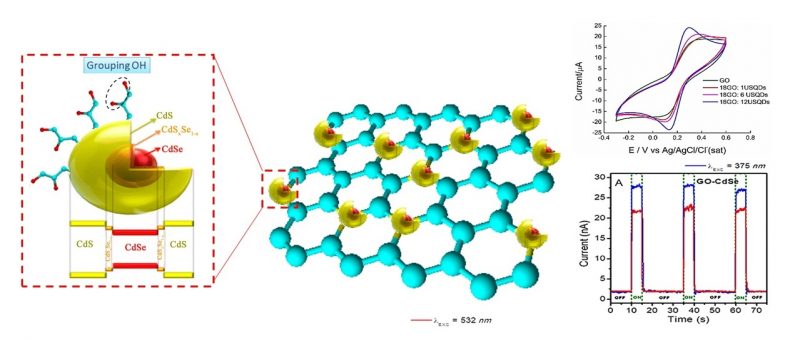
Synergy between nanomaterials
After synthesizing the materials, the researchers used the infrastructure available at three laboratories of the Institute of Physics at UFAL to experimentally investigate the influence of the concentration of quantum dots on the properties of the nanocomposites. This part of the work involved the collaboration of professors, doctoral students and a postdoc from four university research groups.
Based on the results of this collaborative study, Rosinildo and his advisors confirmed that, in the nanocomposite, quantum dots transfer charge carriers (electrons and holes) to the rGO. However, the main contribution of the study was to demonstrate that the rate of this transfer of charge carriers can be adjusted by increasing or decreasing the concentration of quantum dots in the material.
“With the appropriate concentration of quantum dots, we have a greater electrical response of the nanocomposite, enabling to develop new, more sensitive and functional devices,” highlights Professor Anielle Christine Almeida Silva, who is also corresponding author of the paper.
Applications
By illuminating the nanocomposite with a suitable radiation, the quantum dots absorb light, which excites and mobilizes their charge carriers, which are transferred to the rGO. The effect stops when the light is removed. With these characteristics, one of the most distinct applications of the nanocomposite is in quantum dot solar cells. In these devices, which are still experimental but whose efficiency has increased yearly, quantum dots that absorb radiation in the solar light range are used. The high transfer of loads to the rGO is, in this case, a differential.
However, other uses are also promising. Professors Noelio Dantas and Anielle Christine Almeida Silva count on the collaboration of researchers specialized in the development of sensors and biomedical applications. “We are concluding new works that demonstrate the excellent potential of these nanocomposites in improving the electrical response in sensors, as well as their biocompatibility and the development of new theranostic tools,” reveals professor Anielle Christine Almeida Silva. Theranostic platforms are systems, usually nanometric, capable of diagnosing, treating and monitoring health problems.
“The use of these nanocomposites is enormous, from technological applications (solar energy, sensors) to nanobiotechnological applications (biological sensors, theranostic tools),” says Professor Noelio Dantas. According to this researcher “Brazil needs to invest in research that directly contributes to the development of technology, as well as creating programs that bring together and encourage partnerships between companies and researchers.”
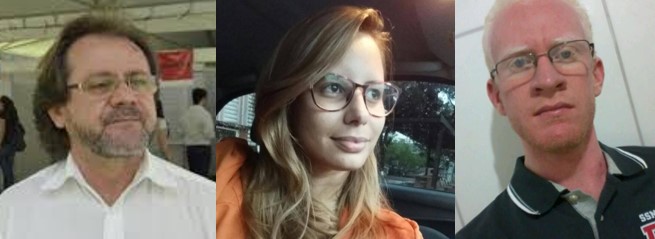
Paper: Tuning the Optical and Electrical Properties of rGO-CdSe/CdS Ultrasmall Quantum Dot Nanocomposites. Rosinildo Fideles do Nascimento, Anielle Christine Almeida Silva, Tasso O. Sales, Artur F. Sonsin, Eduardo Jorge da Silva Fonseca, Samuel T. Souza, Ygor M. de Oliveira, Fabiane C. de Abreu, and Noelio Oliveira Dantas. The Journal of Physical Chemistry C 2021 125 (12), 6805-6811. https://doi.org/10.1021/acs.jpcc.0c09813
Contacts: Profa Anielle Christine Almeida Silva – acalmeida@fis.ufal.br. Prof. Noelio Oliveira Dantas – noelio@fis.ufal.br.
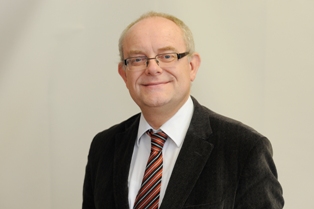
Professor Hellmut Eckert, a member at B-MRS, was honored in early May with a special issue of The Journal of Physical Chemistry C (ACS Publications) which pays tribute to his scientific work in the area of nuclear magnetic resonance applied to materials. Over more than four decades of work, this scientist has produced more than 500 articles published in international peer-reviewed journals.
The edition brings together 53 papers by authors from various institutions around the world in the field of magnetic resonance, in addition to a tribute from the guest editors and an autobiography.
Hellmut Eckert is currently professor in USP, at the São Carlos Institute of Physics (IFSC-USP, Brazil) and a collaborator at the Westfälische Wilhelms Universität Münster (WWU Münster, Germany).
See the special virtual edition: https://pubs.acs.org/page/jpccck/vsi/eckert-festschrift.
|
|||||||||||||||||||||
|
|||||||||||||||||||||
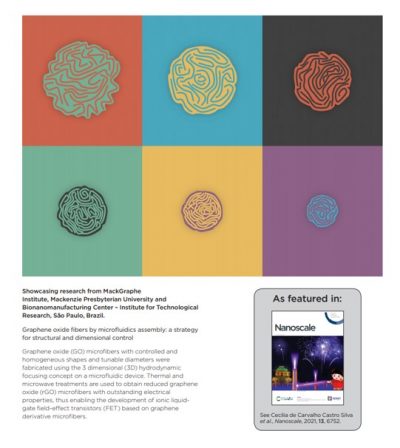
Producing microfibers from materials of the graphene family is a challenge some international research groups have decided to face in recent years. Because they are flexible and can readily conduct electricity, these elongated structures of a few tens of micrometers in diameter have several applications, largely as components of flexible electronic devices. However, the methods for microfibers production have failed as regards the control of their dimensions and shapes, impacting the properties of the material.
Now, a scientific team from Brazil, led by Professor Cecília de Carvalho Castro Silva (Mackenzie), has managed to overcome this challenge through an innovative graphene oxide (GO) processing strategy. The research was reported in an article published in Nanoscale, a journal of the Royal Society of Chemistry, featured on the journal’s back cover. In addition, the paper is part of a special edition of the journal, which brings together the work of young researchers with the potential to influence the direction of nanoscience and nanotechnology, which had the participation of Professor Cecília de Carvalho Castro Silva.
“In this work, we present to the Materials Science and Engineering community a simple strategy to obtain graphene oxide (GO) microfibers with high structural and dimension control, homogeneous shapes and adjustable diameter, through the use of microfluidic,” says Cecília, researcher at MackGraphe, a research center at Mackenzie Presbyterian University focused on graphene and other nanomaterials. The new approach could extend to the production of microfibers based on other two-dimensional or one-dimensional materials.
The work gathered MackGraphe’s expertise in two-dimensional materials for electro-optical devices and the experience of the São Paulo Institute for Technological Research (IPT) in Microfluidics – a multidisciplinary area dedicated to understanding and controlling the behavior of liquid or gaseous fluids on the micrometric scale, using it for this purpose tubes or cameras that confine fluids.
Interaction between fluids
The challenge of the MackGraphe and IPT team was to homogeneously group the graphene oxide sheets, of nanometric thickness, within the desired dimension, forming fibers. Thus, the scientists developed a device composed of needles and micrometric channels that was designed to confine two different liquids so they could interact in a controlled way.
A dispersion of graphene oxide (main liquid) and a compound with coagulating and surfactant properties (support liquid) are injected in the microfluidic device. Both liquids flow together in a channel, in such a way that the support liquid uniformly envelops the main liquid, preventing it from touching the walls of the device. This allows to precisely control the diameter of the fibers leaving the device: the greater the flow of the support liquid, the greater the compression it exerts on the dispersion of GO, and the finer the fibers formed.
To determine how to modulate the diameter of the microfibers according to the flow of the injected liquids, the team used computer simulations. This theoretical work was carried out by researcher Martha Lucía Mora Bejarano, from IPT, using the computational fluid dynamics (CFD) technique.
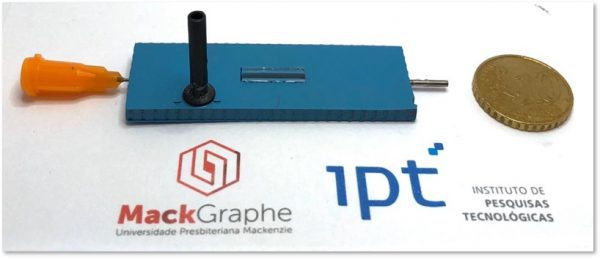
Flexible transistors
The method developed by the Brazilian researchers includes a phase to improve the electrical properties of microfibers. In fact, graphene oxide, compared to graphene, is a material that is easier and cheaper to produce, but due to the presence of oxygenated functional groups in its structure, it is an electrical insulator. However, simple treatments can remove a part of these elements, generating the so-called reduced graphene oxide (rGO), whose ability to conduct electricity reaches levels close to those of pure graphene.
In the work reported at Nanoscale, thermal and microwave treatments were carried out on microfibers to improve their electrical properties. The result was very positive, and the researchers were able to use graphene oxide fibers to assemble transistors (basic components of electronics that fulfill the fundamental functions of turning on, off or amplifying the electric current). Fully flexible, these transistors could be used in the most diverse wearable devices, from sensors for health monitoring to devices for energy generation and storage in electronic tissues.
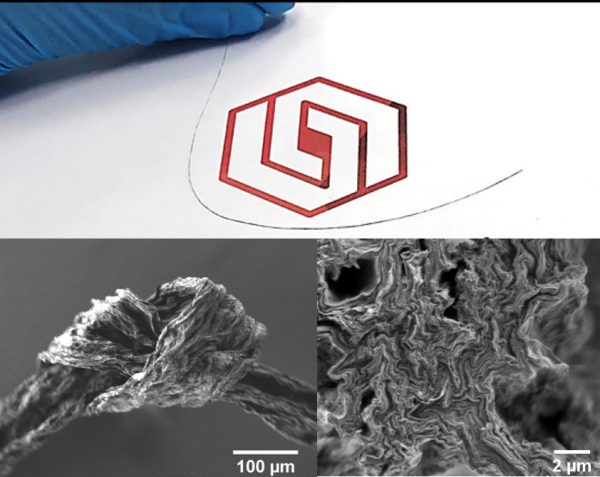
Adding competences
The origin of the study dates back to 2017, when Professor Cecília de Carvalho Castro Silva started to develop graphene oxide microfibers in her newly created research group at MackGraphe, and she faced numerous problems regarding the stability of the mechanical properties of the fibers and the control of its thickness and length.
That same year, Cecília was part of the organizing committee of the VII Microfluidics Workshop, which was held at IPT, in São Paulo. The senior IPT researcher Mario Ricardo Gongora Rubio, who has extensive experience in the development of microfluidic devices, was also on this committee.
“In conversations with Mario, we had this idea of exploring the use of microfluidic devices with 3D hydrodynamics, focusing to obtain GO microfibers with high structural and diameter control,” recalls the scientist. As the strategy had already been shown to be effective in obtaining polymeric microfibers, the research team thought about adapting it to the production of graphene oxide microfibers.
The idea was realized in the master’s degree of Jaqueline Falchi da Rocha, which began in 2018 under the guidance of Professor Cecília de Carvalho Castro Silva in the Postgraduate Program in Materials Engineering and Nanotechnologies at Mackenzie. “We had the opportunity to submit a project to IPT’s New Talents Program, which funds scholarships for promising students to develop research in conjunction with the institute,” reports the researcher. The project was approved, and Mario became the co-supervisor of Jaqueline’s work, whose master’s thesis was defended in July 2020.
The research received funding from the Brazilian agencies CNPq, Finep and Fapesp, the Mackenzie Research Fund and IPT.
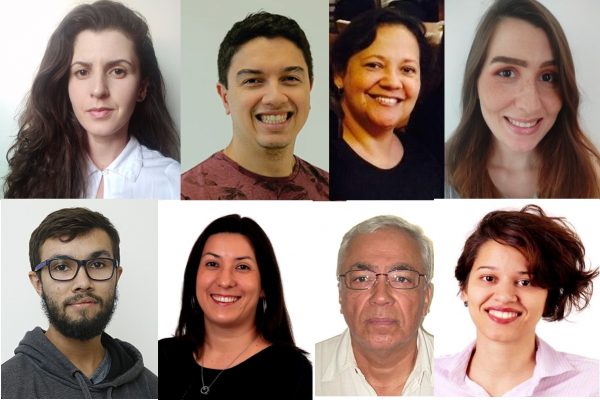
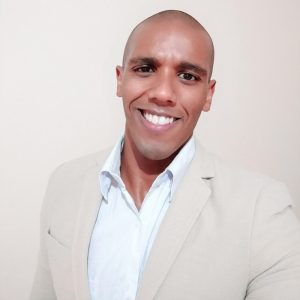
On April 8 of this year, doctoral student Roger Borges had a unique experience. He shared a (virtual) discussion table on the importance of science with 19 other students from Brazilian universities and with the scientist May-Britt Moser, who received the Nobel Prize in Medicine in 2014. Each student was able to ask the Nobelist a question. In another discussion table, another 20 students were able to interact with Serge Haroche, recipient of the Nobel Prize in Physics in 2012.
The discussions took place within the online event “O Valor da Ciência”, which was organized by the Brazilian Academy of Sciences (ABC) and the Nobel Prize Outreach (communication arm of the Nobel Foundation) with support from Instituto Serrapilheira, aimed at promoting reflections on the importance of science for society and public policies based on scientific knowledge. The event was broadcast on the official Nobel Prize channel on YouTube.
To participate in the event, Roger Borges went through a selection process. In the first stage, 90 public and private universities from all regions of Brazil indicated a total of 170 students to ABC. In the second phase, ABC selected the 40 young people who ultimately participated in the discussion tables.
Roger Borges (28 years old) is a member and secretary of the B-MRS University Chapter at the Brazilian Federal University of ABC (UFABC) since the creation of this unit, in 2019. Roger graduated in Science and Technology in 2016 and in Materials Engineering in 2020 – in both cases from UFABC. In 2018, he started a master’s course in Nanosciences and Advanced Materials at the same university, where he currently pursues doctorate in Nanosciences and Advanced Materials. Since his scientific initiation, he has been researching materials based on glass and glass-ceramics for biomedical applications. Both as an undergraduate student and in his doctorate, he has done research internships abroad, more precisely at the University of Idaho (USA), Alfred University (USA) and Politecnico di Torino (Italy). He is co-author of 17 articles published in peer review international journals and 6 book chapters.
Read our brief interview with Roger Borges.
B-MRS newsletter: Participating in a round table with a Nobel Prize winner and with students from different areas and different institutions/regions in Brazil is a unique experience. Comment what most impressed you about this experience.
Roger Borges: Without a doubt, this was a unique experience. Participating in an event with a Nobelist, broadcasted by The Nobel Prize was a great honor for my academic career. However, what most impressed me was the important role diversity played regarding the students chosen. There was gender, race, and regional diversity, as well as in the academic profile. Consequently, the range of questions was incredible! For example, some students from the Northern region asked questions more related to environmental issues, female students asked questions related to feminist issues, a black student asked about the importance of plurality in science, a journalism student asked about how to fight fake news. It is at this moment that the need for diversity in science becomes even more than explicit, as well as affirmative policies that favor this diversity. Society wins, science wins, everyone wins, and nobody loses! I believe that if the round table had no such diversity, it would not have been as successful as it was. In this regard, I congratulate ABC that was intentionally careful to guarantee the diversity of the round table. Having a Science Academy that has this vision is a source of pride for our Brazil.
B-MRS newsletter: At the discussion table with the scientist and Nobelist May-Britt Moser, you asked how international collaboration can reduce inequalities in science and innovation in developing countries. What are your thoughts today on the value of science, innovation and international collaboration?
Roger Borges: We live in an extremely unequal world, where not all countries enjoy equal opportunities for research and investment. I believe that science is the driving force of innovations that can reduce economic and social inequalities between different countries, while science is also the tool that supports implementing policies aimed at reducing these inequalities. This is the remarkable value of science: allowing us to live in a better world and giving us the means to move in this direction. Within this context, I see that reducing inequalities – be they of a scientific, economic or social nature – is everyone’s duty, that is, for the privileged and the least privileged. Thus, international collaboration is a mechanism that allows access to infrastructure and human resources training to those who do not enjoy the same opportunities; in addition to being a way to collaborate scientifically in order to develop innovations and policies that lead us to a more equitable world.
B-MRS newsletter: You participate in the B-MRS UC Program, you are a member of the Brazilian Association of Black Researchers (ABPN), you have participated in Brazilian student associations abroad. You probably think it is important to participate in peer groups. Comment a little on this question.
Roger Borges: I carry a thought that guides my actions: whoever writes the story decides what to give visibility to and what to drop into oblivion. When you get involved in a group/association that works for causes aimed at social and/or scientific development, you can contribute to this group and help write the story. It is at this point that you help to decide what to give visibility to. Thus, you can contribute to improvements, give your perspective, in short, help write the story in how you believe it would also be satisfying for others and for you. So, getting involved with groups and agendas that are important to us is the approach we find to make our contribution in an active and more effective way. Getting involved in what we believe is extremely important – and it is also very enriching! We learn a lot, get updated, it’s really an exchange that helps us become better people and professionals.
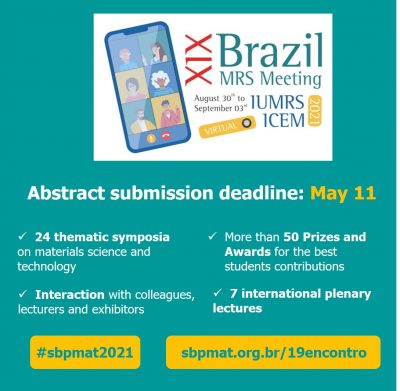 Dear Colleague,
Dear Colleague,
We know that, after a year without the B-MRS annual meeting, our community is particularly eager to meet again around high quality science. That is why our organizing team has been working hard to ensure an interactive and fruitful virtual event this year.
In the joint event XIX B-MRS Meeting + IURMS ICEM, from August 30 to September 3, we will offer you all the possibilities to exchange information, network and chat with colleagues, lecturers and exhibitors, in a multidisciplinar and international environment.
This year, our meeting comprises 7 plenary lectures by leading scientists from around the world and more than twenty thematic symposia with invited, oral and poster sessions covering fields ranging from Biomaterials to Electronic Structure Calculations.
The meeting also features a virtual exhibition of products and services for the materials research community. And, of course, we will enjoy virtually our traditional Memorial Lecture in the opening session and, at the end of the event, the exciting Student Awards Ceremony, where more than 50 prizes and awards will be given.
Abstract submission is open until April 25th May 11th. Submit your abstract, invite your collaborators. Join us for the largest conference in the area of Materials Science in Latin America.
Kind regards,
Prof Gustavo Dalpian (Conference Chair)